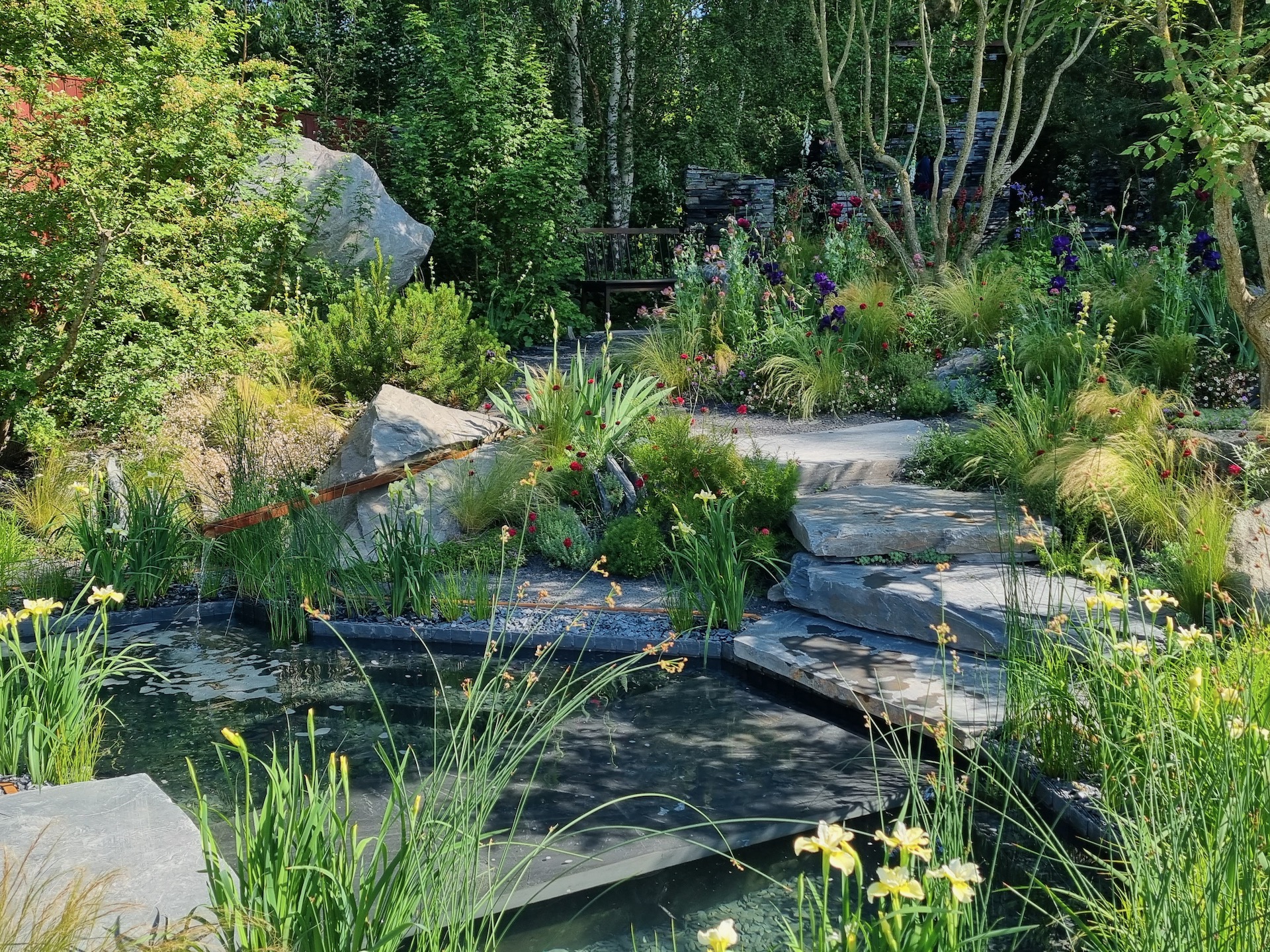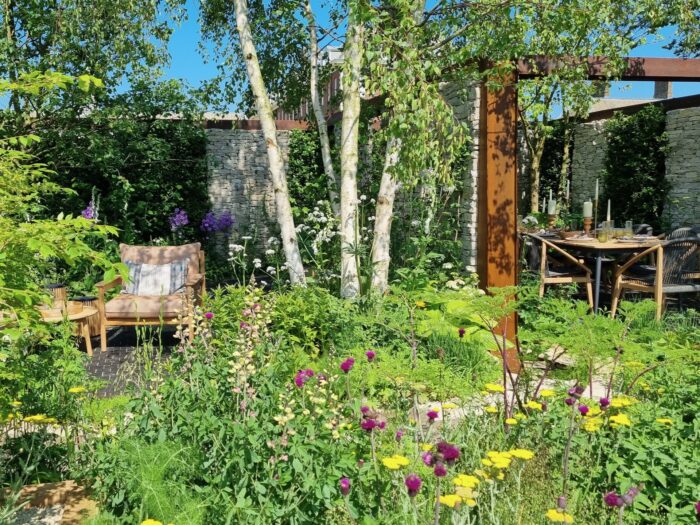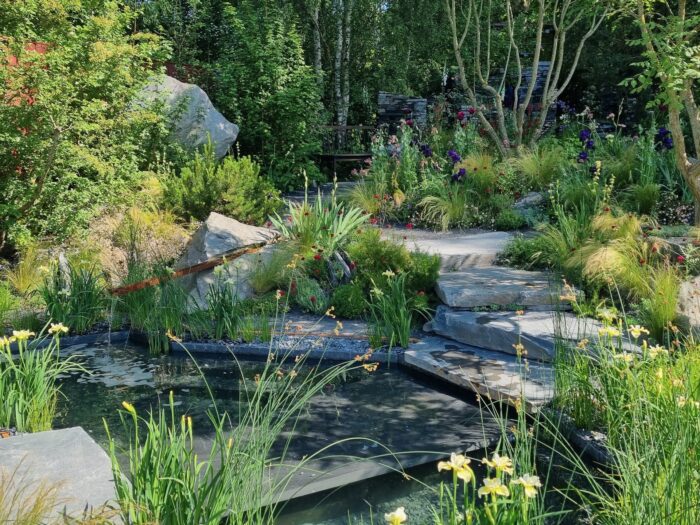
Terrence Higgins Trust Garden at RHS Chelsea 2024. Image credit: Amy Cutmore
Our favourite garden ideas to steal from RHS Chelsea Flower Show 2024
There’s more than one good reason why the RHS Chelsea Flower Show is the highlight of the UK’s horticultural calendar. But stunning scenery, Champagne sipping and celeb spotting aside, the thing that we look forward to the most is the inspiration that each garden and stand, large or small, gives us.
And we’re happy to report that RHS Chelsea 2024 doesn’t disappoint – if anything, it’s the biggest and best version of the show we’ve ever attended. From the stunning Show Gardens and spectacular plant specimens on show in the Grand Pavillon, to the House Plant Studios and small but perfectly formed Balcony and Container Gardens, there truly is something for everyone – and every plot – at this year’s edition.
We’ve picked some of our favourite themes that we hope will inspire a few tweaks to your garden this summer. Not only will they enhance your outdoor (or indoor) space visually, they tackle climate challenges and can even enhance our wellbeing.
Water-saving design
While drought-tolerant planting has been a recurring theme at RHS Chelsea for the past few years, 2024’s gardens are doing more than ever to celebrate and manage that most precious of resources – water. The star of the show in this regard is the WaterAid Show Garden, designed by Tom Massey and Je Ahn. Its sculptural focal feature provides shade for the people and plants below, but also catches rain that nourishes the plants planted high above, before funnelling it down for later use elsewhere in the garden.
Even the walkway, made from steel, is grated and fully permeable so that light and water can reach the planting and wildlife underneath. The alder trees also do their bit, capturing nitrogen and absorbing toxic heavy metals to tackle contamination in the soil.

Of course, it may not be possible to create such a grand structure in your garden, but the show boasted plenty of more modest water-harvesting features. Like these rain chains – a decorative alternative to guttering that can draw water down into either a butt or a pretty water feature.

Or this clever balcony garden, Tomie’s Cusine the Nobonsai, which features a living drain at the top. Water filters through the soil, and down a rain chain into a water tank below. The overflow is filtered to planters that frame the front of the balcony.

And finally, The Water Saving Garden by Affinity Water had a host of water-retaining measures, including slim-line butts, and self-watering planters that store water and deliver it to plants’ roots by capillary action.

Forest gardens
Within minutes of stepping through the gates of Chelsea, we were struck by the number of pocket-sized woodlands that had cropped up around the site. Impressive tree canopies were casting dappled sunlight across a host of gardens – including the gold-medal winning and best in show Muscular Dystrophy UK – Forest Bathing Garden.

“Forest gardens help people to unwind and connect with nature; that’s increasingly important for those with busy lives,” says the garden’s designer Ula Maria.
“I wanted my Show Garden to be a sanctuary-like space and came across Shrin-yoku, the ancient Japanese practice of forest bathing… it’s the simple act of mindfully being in the forest, though you don’t need an actual forest to feel these effects.”
Spending time ‘bathed in nature’ has been said to lower heart rate, improve blood pressure and lower levels of cortisol, a stress hormone. And while you might think this look is impossible to create in a humble urban garden, you’d be surprised at what can be done on a pint-sized plot. In her garden, Ula has planted more than 50 trees, including silver birch (Betula pendula), Chinese red birch (Betula albosinensis), Black alder ‘Fascination’ (Alnus glutinosa) and Hawthorn (Crataegus varieties).

Another garden that indulges in forest bathing is The National Garden Scheme’s naturalistic scheme, which transforms visitors to a copse planted with common hazel (Corylus avellana). A mixed hedge of mostly native species including hawthorn and field maple wraps around the boundary.
Ecotherapy
It’s not just trees that can contribute to our wellbeing. Several gardens had wider themes of ecotherapy – the immersing of oneself into the natural world. The aptly named Ecotherapy Container Garden designed by Tom Bannister impressed us with its series of pools, providing a soothing soundscape of cascading water to rejuvinate physical and mental wellbeing.

Elsewhere at the Stroke Association’s Garden for Recovery, colourful blooms, scent and the sound of lapping water provide a sensory space where visitors can find themselves and start a journey of recovery after a stroke.
Recycled landscaping
Many gardens have taken a ‘reduce, reuse, recycle’ to landscaping at this year’s Chelsea – none more so than the RHS Chelsea Repurposed Garden, which as the name suggests, uses key elements from Chelsea gardens past to create a whole new design.
Features you may recognise include colourful scaffold boards and timber from Cityscapes’ 2022 St Mungo’s Putting Down Roots garden at the rear, and corton steel columns that previously appeared in Andy Sturgeon’s 2010 The Daily Telegraph Garden. Even the drought-tolerant grasses and wildflowers are planted in salvaged crushed concrete and sand.

Elsewhere, one of our personal favourite gardens, the Pulp Friction Growing Skills Garden, features gabion boundaries filled with waste materials gathered from other exhibitors. Bricks, logs, slate and other found items create a fabulous habitat for bugs and other wildlife.

The rear oak wall is constructed from waste slab wood, a by-product from the milling process, donated by Whitney Sawmill and Woodland Heritage. The decorative halo and other structures have been bound in recycled fire hose, which symbolises the relationship with the Pulp Friction charity and the Nottingham Fire and Rescue Service.

Gardens as communication spaces
Following on from 2023’s Memoria & GreenAcres Transcendence Garden, which was designed to encourage us to have difficult conversations around grief, several gardens at RHS Chelsea 2024 have been given dedicated spaces for quiet contemplation, sensitive one-to-one chats, and even counselling.
Our personal favourite is the stunning Killik & Co: Money Doesn’t Grow on Trees Garden, which has three separate areas – a dining area underneath a steel pergola for family gatherings; a side-by-side bench for quiet chats; and loungers cushioned by planters.

Elsewhere, the St James’s Piccadilly: Imagine the World to be Different garden features a cabin for counselling sheltered by gingko, magnolia and nettle trees for privacy. The entire garden – including the drop-in counselling space – will be relocated to the church yard in the heart of London.

The Sue Ryder Grief Kind Garden carries on from Memoria’s good work, with a seated area where bereaved visitors and residents of the Sue Ryder St John’s Hospice in Bedford will be able to open up to the charity’s team.
And the gold-medal winning Freedom from Torture Garden: A Sanctuary for Survivors uses sculptural screens of willow (described by the designers as ‘streams’) and a sunken communal bread oven to both create ‘dens’ where users can engage in one-on-one therapy, or come together to share stories and build new friendships.

Chaos gardening
Another trend that has continued on from last year’s RHS Chelsea is ‘chaos gardening’. Rather than stick to defined and orderly borders, garden designers are embracing a more naturalist approach to planting – often bringing wildlife-nurturing wildflowers and woodland plants into the mix.

To have a go at chaos gardening yourself, you can simply gather up any leftover seeds you have lying around – whether they are vegetables, grasses, herbs or flowers – mix them all up and then scatter them onto your soil.
For more guaranteed (and coordinated) success, you could also use a dedicated wildflower mix – we recommend any of the ranges available at Seedball. This year, the company has teamed with WaterAid Garden designer Tom Massey to create a special drought-tolerant wildflower seeds mix for his gold-medal winning show garden.

You’ll also see the ‘chaos’ approach at the RHS X UBS A Day on the Nursery Garden, where raised beds feature a mix of companion and mixed edible and ornamental planting, where vegetables, wildflowers, herbs and even mushrooms grow together side by side.





